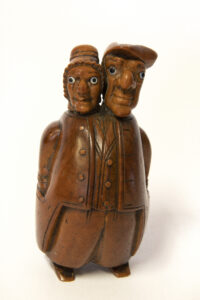Liberty and Anti-Slavery Representation: Martha and George Washington

MARTHA AND GEORGE WASHINGTON Double-headed Coquilla nut snuff box depicting Martha (left) and George (right) Washington, ca.1800. Height: 4 in. (10.3 cm); width 1.9 in. (4.8 cm).
David Badger’s extraordinary collection of snuff boxes provides evidence of anti-slavery and abolitionist sentiments on both sides of the Atlantic, including figures prominent in Revolutionary America. Several important figural snuff boxes depict American leaders from the early Republic who opposed the institution of slavery. Examples include John Brown, Thomas Paine, John Quincy Adams, and Benjamin Franklin. A particularly unusual double-headed snuff box portrays Martha and George Washington in a critical light—showing George with horns over his eyes— a rare, overt, negative commentary on the Washingtons’ ownership of slaves.
The Washingtons, unlike other prominent families like the Adams, Franklins, or Paines, continued to keep enslaved people on their plantation until their deaths. According to the Mount Vernon website, 317 enslaved laborers worked at Mount Vernon in 1799, the year of George’s death; 123 were owned by George, the others by Martha, who inherited slaves from her former husband’s estate. Washington’s will released his slaves upon Martha’s death, and Martha signed a deed of manumission in December 1800 (although some of Martha’s inherited slaves were disposed of as inherited chattel from her first husband to her descendants).
The story of Ona Judge, Martha Washington’s personal maid who escaped enslavement from the Washingtons, is documented in the historical record. Ona fled the estate and became a “fugitive slave.” Despite efforts to recapture her, she never returned to Mount Vernon.

GEORGE WASHINGTON
Side view of George Washington, showing the protruding horn over George’s right eye (the horn over the left eye was damaged). The tricorne hat and the toothless extended lower jaw are both Washington signifiers. His exaggerated chin also contributes to this portrayal being less than flattering.
The unique double headed snuff box shown below was carved from one of the largest and widest nuts in the Badger Collection. The original nut had to be cut in length to accommodate a neck with two heads, and the base was squared for the two pegged feet. The worked body length of this nut without the shoes is 2.6 inches (6.5 cm); overall height is 4 inches (10.3 cm); and width is 1.9 inches (4.8 cm). It is likely that the heads were carved by a portrait specialist while the bodies were made by another carver.
The Badger collection also contains a series of important liberty-themed snuff boxes representing abolitionists and anti-slavery/colonial figures from different countries, many featuring the “Cap of Liberty,” a symbol of revolution.
These boxes display a diversity of approaches and references to the subject. Carvers depicted both slaveholders like the Washingtons as well as abolitionists and philanthropists. Various representations may have been driven by audience and public demands, as throughout the nineteenth century, people in the United States, Britain, and elsewhere collected, displayed, and produced objects and images that spoke to their personal stances on the still-unresolved slavery question. These boxes may have been among the valued objects in the wider visual arena of abolitionist sentiment and likely commanded a diverse clientele across racial and class lines.